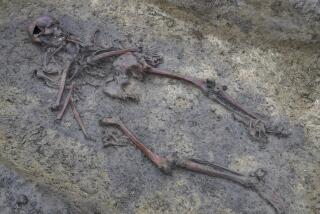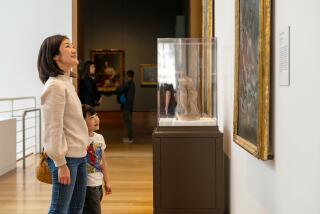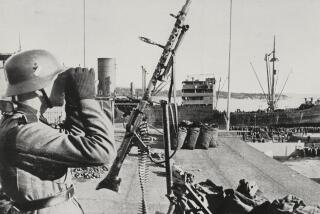Visit to Past Is Possible in Nordic Folk Museums
- Share via
COPENHAGEN — If you prefer to step into a country’s history and culture amid natural surroundings rather than in museums and concert halls, hitch a ride to the Nordic lands.
Loving the outdoors, Scandinavians have established scores of open-air folk museums to provide a view of life in the past.
Through the years, workers in Sweden, Norway, Finland and Denmark have carefully dismantled old farmhouses and other buildings and re-erected them in more than 60 parks.
The largest are in or near the capitals of the four Nordic countries where travelers are able to visit the furnished buildings. They see weavers, spinners, glass blowers, potters, jewelers and other craftsmen at work as they were centuries ago.
Entry fees are nominal, ranging from free, if you have earlier bought a city card (available in most Scandinavian capitals), to $1.25.
Pastoral Setting
At Lyngby, 15 minutes by train from Copenhagen, the Danes have re-created one of the most picturesque parks in a pastoral setting, covering probably the largest area of any folk museum in Scandinavia. Called Frilands (open air), it’s spread over 90 acres and contains structures built between 1580 and 1880.
Some of Frilands’ farmhouses are huge, having been owned by wealthy freeholders or used by several families. The oldest building was erected in 1580 of rectangular stone slabs, heavy wooden crossbeams and posts. It was reassembled after being brought to Lyngby from northern Germany, which at the time was part of Denmark. Others include fishermen’s and skippers’ cottages from the North Sea coast, a windmill from Zealand, water mill from Funen and bridge from Jutland.
Each of Frilands’ old farmsteads and cottages was measured and photographed before being taken down, then rebuilt stone by stone.
Houses equipped with furniture and utensils of the period provide vivid impressions of living conditions long ago.
During summer, horse-drawn carriages take visitors around the park for an additional fee. At the farms, work is carried out as it was 100 to 200 years ago--sheep shearing, wool carding and flour ground by a wheel turning in a water mill. Folk dancers in colorful regional costumes perform, and guides conduct tours in several languages.
Few Americans
Frilands draws 200,000 visitors each year. One in 10 is a foreigner, many from Germany and France, but only about 1,000 of them are Americans.
The oldest and most popular outdoor folk museum in Scandinavia is Stockholm’s Skansen, on one of the Swedish capital’s four islands. The Nordic answer to Disneyland, but in no way resembling the mighty mouse’s California habitat, Skansen sprawls across 75 acres of a hilly park that overlooks one of the world’s most spectacular cities. Two million people pass through its turnstiles annually.
Its founder, Artur Hazelius, aimed not only to reassemble 150 farmhouses and other buildings from various regions of Sweden, but also to bring whole farms to life.
In each room the correct furniture was set in its correct place. In sheds the right tools and implements were hung. Visitors can wander into a bakery, bookbindery, flax mill, chipping house, laborer’s cottage, country school, herb garden, church, pharmacy, tannery and workshops for a comb maker, goldsmith, saddler and cobbler.
In Skansen’s Town Quarter visitors gain an idea of the social strata of centuries ago. Farmers who owned land lived in far more luxurious farmsteads than those who rented land or worked for large estates.
Lapps will show you how their ancestors lived decades ago as nomads who rounded up their reindeer for breeding and lived in camps with turf-covered tepees and raised huts. Today these hearty people use motor scooters, airplanes and radios to collect the 100,000 reindeer they still herd in northern Norway, Finland and Sweden.
Skansen is 10 times larger than when it opened in 1891. Old customs and traditions enliven the park--outdoor folk music and dancing on summer evenings, a Christmas market, holiday festivals and sometimes bonfires. We were there in midsummer and saw them trim a maypole with birch boughs and wildflowers for families to dance around during the period when it’s light through the night.
Animals and Concerts
Skansen is not only a folk museum, but also has a zoo, concerts, theaters, art and cultural exhibitions, plus a children’s zoo where youngsters can play with baby goats, chicks and other tame animals.
A few hundred yards down the street from Skansen is Grona-Lund, Stockholm’s counterpart of Copenhagen’s well-known Tivoli Gardens amusement center.
Like Skansen, Seurasaari in Helsinki also stands on an island. Its grounds contain a tar boat, water mill, granary, church, sawmill and smoke huts, along with old farm and manor houses typifying life during the past 400 years. During our visit, coffee and cakes were served to us by a costumed Finnish girl who later performed as one of a Helsinki folk dancing group on an outdoor stage.
Olso’s folk park on the Bygdoy Peninsula boasts 170 old wooden buildings from Norway counties that were painstakingly dismantled at their original sites and re-erected in the capital. Grass and flowers grow from the sod roofs as they did 300 years ago. During summer we found even strawberries and tiny trees sprouting on some roofs.
Inside, visitors view more than 150,000 farm implements and forestry gear, tapestries, paintings and woodcarvings typical of Norwegian cultures in past centuries. Playwright Henrik Ibsen’s study has been set up as it was in his Oslo home until his death in 1906. Ancient instruments are played during museum recitals.
A highlight of Olso’s folk museum is a stave church from Gol estimated to be 800 years old. The church walls are pierced by holes for lepers to watch services from outside. Dragon heads, believed to be from pagan Viking temples, are carved on the walls to fend off evil spirits.
As in Stockholm, Oslo’s museum shows how the Lapps, who still inhabit Finnmark, Norway’s northernmost county, lived in bygone centuries.
The museum can be reached by either bus (No. 30 marked “Bygdoy”) from in front of the National Theater or by ferry from the Town Hall to Dronningen.
While the largest are in the four capitals, other open-air museums are in numerous cities and towns throughout Scandinavia. Norway has 27; Sweden, 22; Denmark, 7, and Finland, 34.
At Gotenborg, Sweden’s largest port and second city, dwellings at Klippan Museum date from the 7th Century. On Sweden’s west coast at Halmstad, a major resort, is another open-air museum, this one sporting a Miniland with scale models of famous Swedish buildings. Additional folk compounds are at Linkoping and Karlstad in Varmland.
Life in the Iron Age
In Denmark other folk museums, besides Copenhagen’s Frilands, are at Odense on Funen Island and Hernins in the middle of Jutland. At Hjerl Hede in northern Jutland, mills, farms, schools and churches are inhabited during summer so visitors can view how folks lived in the Iron Age (1000 BC and AD 100).
Another unusual open-air museum is the Old Town at Arhus, Denmark, where visitors can study how urban life developed over 250 years beginning in 1600. Most other outdoor museums concentrate on rural buildings.
In Bergen, Norway, city fathers have transplanted old buildings of this picturesque city and set them up at Gamle Bergen near the harbor entrance. Gamle Bergen, like other parts of the city, has cobblestone streets and twisting lanes.
Surrounding the ruins of King Sverre’s 800-year-old castle in Trondheim on Norway’s western fiord coast, the Troendelag Folk Museum has 60 reconstructed old buildings. They include sun-scorched mountain farms and weather-beaten boathouses, Lapp turf huts, city residences and large farmhouses. An old public house, The Tavern, is open summer afternoons.
At Turku, Finland’s oldest city, the open-air museum Turun Maakuntamuseo is a five-minute walk from the center of town on Cloister Hill. Unlike other folk parks where structures have been reassembled from throughout the country, Turku’s consists of houses that survived a fire in 1827 that razed most of this ancient capital. In shops here during summer, potters, weavers and other craftsmen will let guests try to use the same centuries-old techniques that they do.
Turku, meaning “trading post,” can be reached by a three-hour bus ride from Helsinki or via ferry through a scenic Baltic archipelago on a day-long voyage out of Stockholm.
As they say in Stockholm and Oslo, “ Ha en fantastisk resa ,”--”Have a fantastic journey.” You can hardly do otherwise.
More to Read
Sign up for The Wild
We’ll help you find the best places to hike, bike and run, as well as the perfect silent spots for meditation and yoga.
You may occasionally receive promotional content from the Los Angeles Times.






